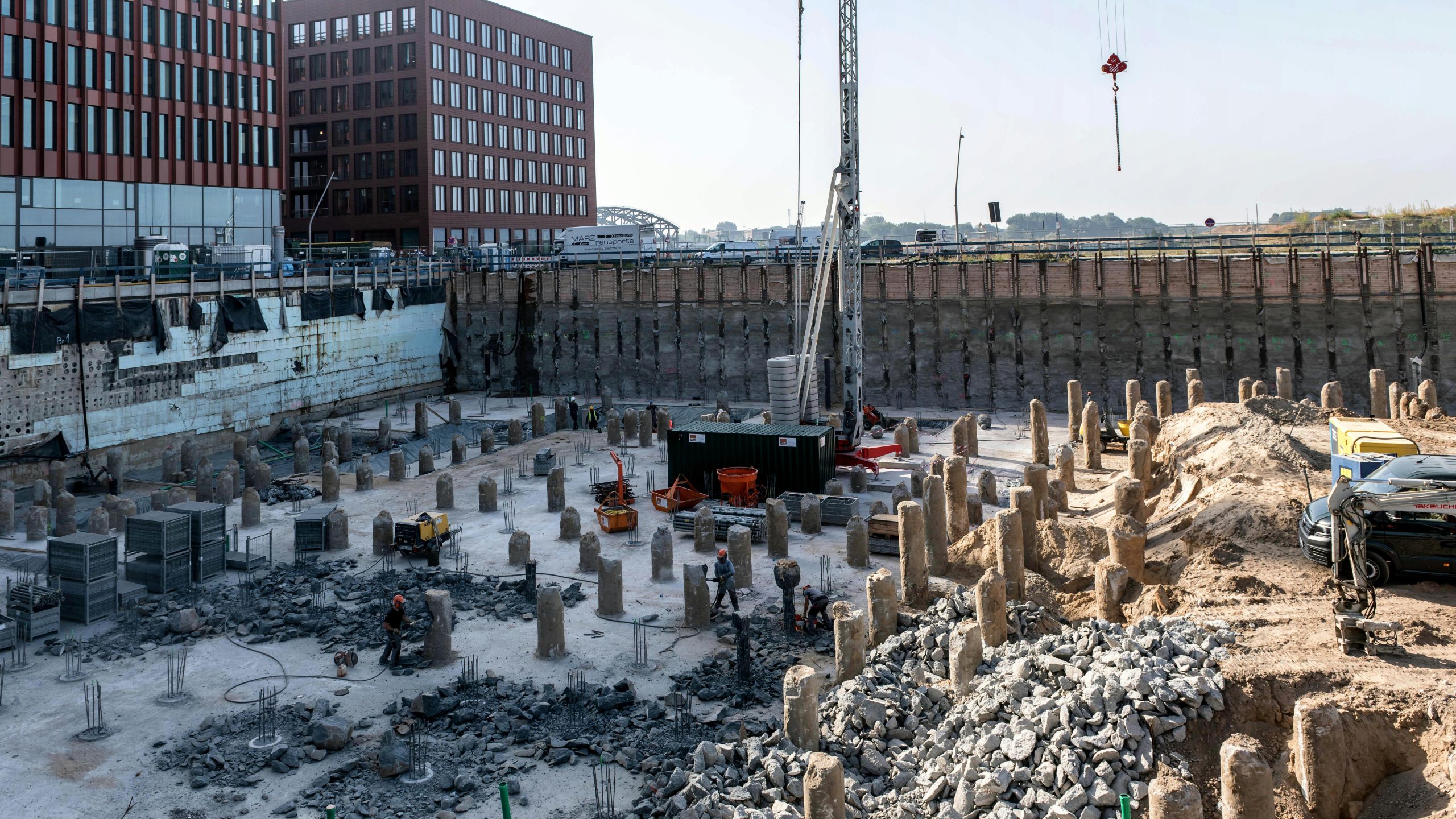Dynamic replacement construction strengthens weak soils by creating compacted granular columns deep underground. This method improves bearing capacity, reduces settlement risks, and often eliminates the need for costly deep foundations. By displacing unsuitable material with engineered fill, it offers a versatile, cost-effective solution for stabilizing challenging ground conditions while minimizing environmental impact and construction disruption.
Understanding Dynamic Replacement Construction
Dynamic ground improvement techniques offer a modern approach to stabilizing and strengthening soils where traditional methods fall short. Among these, the Dynamic Ground Replacement Services stand out as an innovative solution designed for challenging ground conditions. This technique involves the installation of large diameter granular columns within cohesionless soils, providing substantial load-bearing improvements with minimal environmental impact.
Also to see : Expert electrician services in blackheath: quick & reliable
Unlike conventional dynamic compaction and soil stabilization methods, dynamic replacement employs equipment such as tracked cranes and heavy weights to induce deep displacement and densification. It drives selected granular material into the ground, creating columns that reinforce weak layers while maintaining the natural profile of the site. This process is especially advantageous in areas with organic, saturated, or contaminated soils conditions where traditional methods often struggle to achieve desired results efficiently.
Differentiation from Traditional Methods
- Traditional dynamic compaction relies on repeatedly dropping weights to densify soils, primarily affecting the surface and shallow layers.
- Soil stabilization often uses chemical additives or grouting, which may be ineffective in deeply layered or organic soils.
- Dynamic replacement distinctly forms large diameter reinforcement columns that penetrate deeper, up to 15 meters depending on site conditions and equipment used.
The advantages are notable: enhanced load capacity, reduced settlement, improved permeability, and potential cost savings by eliminating the need for deep foundations or piles. Its ability to treat various weak soils, including fills and cohesive sediments, makes it highly versatile for diverse geotechnical challenges.
Topic to read : Transform your smile with a top cosmetic dentist in leeds
Principles and Process of Dynamic Replacement
Dynamic replacement represents an advancement among dynamic ground improvement techniques, applying high-energy impacts for in-situ soil treatment processes to stabilize challenging sites. The technique starts with a rigorous geotechnical site investigation to confirm the suitability of dynamic replacement over alternatives such as vibro replacement or static compaction. After soil engineering properties testing, specialized design criteria are developed, accounting for factors like load-bearing capacity improvement, soil modulus increase techniques, and desired ground settlement reduction methods.
Technical Foundations and Design Criteria
The foundation of dynamic replacement lies in the application of significant energy input during soil treatment—typically by dropping weights from substantial heights onto the ground surface. This energy transmission causes granular fill material, like coarse stone, to penetrate and displace the in-situ soil, forming deep, compacted columns. These columns provide effective construction foundation enhancement and ground densification benefits, even in weak or organic soils, making dynamic replacement essential for projects where soil densification vs soil replacement must be carefully considered. Dynamic replacement design criteria hinge on the thickness of weak layers, required load transfer mechanisms in improved soils, and the performance metrics needed for optimal foundation failure prevention.
Implementation Steps and Equipment
Dynamic replacement project planning follows a clear step-by-step dynamic replacement procedure optimized for construction timeline optimization and safety. Site preparation involves installation of a stable working platform to distribute machinery loads. Tracked crawler cranes equipped with heavy drop weights—ranging between 10 and 20 tons—perform controlled drops from up to 20 meters, allowing for effective vibration-based soil compaction. After each drop, the granular soil replacement processes advance as stone aggregate is placed into the resulting craters, with repeated cycles until dense, reinforced soil columns form. Field testing of soil compaction assures that soil compaction quality control standards are met. Dynamic replacement equipment and tools—including drop weights, cranes, and vibration monitoring devices—must be maintained and calibrated for safety and effectiveness.
Safety Measures During Implementation
Executing safety measures during soil replacement is critical to prevent negative impacts on nearby structures and ensure regulatory considerations in soil improvement. Vibration monitoring during construction is an integral part of ground vibration monitoring techniques, alerting engineers if vibration frequency and amplitude effects approach cautionary limits set for the environment or adjacent buildings. Additional precautions control vibration impact on urban construction sites, using instrumentation for soil behavior analysis to detect risks in real time. Environmental impact of soil replacement is minimized by using recycled aggregates where permitted and by carefully controlling soil particle rearrangement effects to avoid ground disturbance beyond the treatment zone.
Dynamic replacement’s integration of geotechnical engineering fundamentals, advanced equipment, and stringent quality assurance makes it a preferred solution for engineering foundations for heavy loads, especially in dynamic replacement for infrastructure projects or seismic soil reinforcement scenarios.
Benefits, Applications, and Performance Outcomes
Load Transfer Mechanisms in Improved Soils
Dynamic ground improvement techniques such as dynamic replacement fundamentally increase the load-bearing capacity of weak soils. This is achieved through a systematic process using vibration-based soil compaction and in-situ soil treatment processes, where a heavy weight is dropped repeatedly to drive granular materials into the soil, forming reinforced stone columns. These columns create effective load transfer mechanisms in improved soils by distributing applied loads through stiffer, denser columns into deeper, more competent strata. As a result, the risk of foundation failure is minimized, and total as well as differential settlements are mitigated. The improvement of weak soil layers, especially those prone to compressibility or subject to liquefaction, can also be quantified by enhanced soil modulus increase techniques and reduction in soil void ratio, boosting long-term ground stability.
A key outcome from employing ground densification benefits via dynamic replacement is the ability to improve foundation support without extensive excavation. Ground reinforcement for high-rise buildings, infrastructure, and industrial projects becomes more viable, particularly in scenarios where construction foundation enhancement must withstand heavy or dynamic loading.
Advantages Over Traditional Methods
Compared with older soil stabilization methods, the dynamic compaction vs dynamic replacement debate often favors the latter for soils that are highly compressible, organic, or waterlogged. Dynamic replacement equipment and tools are specifically designed for such challenging conditions, while traditional static compaction often falls short. Cost-effectiveness of ground improvement is a noted advantage: eliminating the need for deep piles or mass soil removal reduces both material costs and construction timelines.
Another benefit is the minimal environmental impact of soil replacement. By relying on granular soil replacement processes and allowing for the use of recycled aggregates (where approved), dynamic replacement helps avoid the costly and disruptive removal of unsuitable materials. This supports sustainable practices in foundation strengthening and contributes positively to environmental sustainability in soil treatment, while reducing on-site vibration-related disruption using precise ground vibration monitoring techniques.
Versatility is further reflected in treating a broader spectrum of soils—from soft cohesive material to granular fills—making it valuable for dynamic replacement in earthquake-prone areas or wherever load-bearing capacity improvement is essential. This adaptability enhances site preparation for heavy construction even in constrained urban environments.
Typical Applications and Case Studies
Dynamic replacement sees wide civil engineering applications, from commercial and industrial projects to essential infrastructure initiatives. Among ground improvement project case examples, projects like highway embankments, wind farms, water treatment plants, and industrial floors demonstrate how ground settlement reduction methods can be tailored to project needs. This includes the dynamic replacement for liquefaction mitigation, offering additional seismic soil reinforcement when required.
Detailed field testing of soil compaction and soil engineering properties testing is used to verify the effectiveness of dynamic replacement, with ground densification benefits and load transfer mechanisms in improved soils evident through real-world performance data. Metrics tracked include immediate and long-term ground settlement, enhanced soil permeability improvement for better drainage, and the increased stability of foundation support upgrades under operational loads.
Limitations and Challenges
Despite its versatility, dynamic replacement has site-specific constraints. The depth influence is limited by the drop weight and the capabilities of dynamic replacement equipment and tools, which can restrict treatment in very deep or highly stratified soils. Compatibility is best with soils that respond well to vibration-based soil compaction and granular fill, while very cohesive clays or extremely soft materials may require adaptation or supplementary soil layer replacement strategies.
There are also practical challenges in soil replacement: vibration impact on urban construction sites must be carefully managed to avoid adverse effects on nearby structures—addressed via strict vibration monitoring during construction and adherence to regulatory considerations in soil improvement.
Construction quality assurance in soil work is essential to ensure consistent outcomes, with safety measures during soil replacement being strictly enforced through ground vibration monitoring techniques and regular instrumentation for soil behavior analysis. Such controls safeguard the integrity of engineering foundations for heavy loads and promote reliable long-term performance of treated soils, solidifying the role of dynamic replacement in modern geotechnical engineering.
Technical and Environmental Considerations
Dynamic ground improvement techniques demand not only technical precision but also careful environmental evaluation. When implementing vibration-based soil compaction as part of dynamic replacement, ground vibration monitoring techniques are paramount. Instruments—such as geophones and accelerometers—track vibration levels during the step-by-step dynamic replacement procedure to prevent damage to nearby infrastructure and minimize nuisance to local communities. Monitoring ensures that the dynamic replacement equipment and tools used do not induce vibrations exceeding regulatory thresholds.
During the project, granular soil replacement processes can have direct and indirect impacts on groundwater flows, soil permeability improvement, and local ecosystems. For civil engineering applications, it is essential to measure the effect of dynamic replacement on groundwater, as changes in soil void ratio reduction and soil consolidation in dynamic replacement may alter hydrological conditions. This monitoring helps prevent unintentional migration of contaminants and assures compliance with environmental sustainability regulations throughout the entire process.
Standards, Guidelines, and Regulatory Aspects
Strict adherence to geotechnical engineering fundamentals and dynamic replacement design criteria is foundational for safety and effectiveness. Regulatory considerations in soil improvement require geotechnical site investigation importance early in the project timeline, ensuring that all load-bearing capacity improvement and soil engineering properties testing are based on robust, site-specific data. Pre-construction soil condition assessment and dynamic replacement feasibility analysis facilitate proper project planning, from soil layer replacement strategies to the choice of fill material selection for dynamic replacement.
Guidelines set forth for contractor guidelines for ground improvement detail minimum requirements for soil compaction quality control, field monitoring methods, and safety measures during soil replacement. Permitting procedures depend on local regulations and require comprehensive documentation of soil structure interaction, ground settlement reduction methods, and the potential impact of dynamic replacement on nearby structures.
Environmental Sustainability
Optimizing construction foundation enhancement relies on integrating environmental sustainability in soil treatment wherever possible. Many advanced geotechnical solutions now specify the use of recycled aggregates in vibration-based soil compaction, not only for dynamic replacement but also when comparing soil densification vs soil replacement. This approach significantly reduces the environmental impact of soil replacement, lowering carbon emissions linked to material transport and waste. Sustainable practices in foundation strengthening, such as minimizing energy input during soil treatment, further enhance environmental credentials without sacrificing the ground densification benefits vital to modern construction.
Long-term Performance and Maintenance
Dynamic ground improvement techniques deliver enduring results when coupled with effective post-construction strategies. The durability of treated soils is tracked through continued field testing of soil compaction and targeted ground vibration monitoring techniques. For infrastructure projects, monitoring procedures look for changes in soil strength increases after treatment and analyze performance metrics such as load transfer mechanisms in improved soils.
Over time, maintenance activities may target secondary benefits of soil replacement such as reducing long-term settlement or preventing groundwater migration. These efforts are supported by soil compaction vs dynamic replacement comparative tests, construction quality assurance in soil work, and the use of innovative soil treatment technologies to confirm ongoing subsoil strengthening. Regular evaluation ensures foundational support upgrades are not only achieved during initial construction but are reliably maintained for the life of the structure.
Innovative Techniques, Equipment, and Future Trends
Advanced Dynamic Replacement Equipment and Tools
Within modern construction, dynamic replacement equipment and tools have rapidly evolved to enhance the results of dynamic ground improvement techniques. Contemporary tracked crawler cranes now deliver controlled drops of heavy compaction weights from significant heights, typically up to 20 meters, enabling dynamic replacement to achieve effective soil stabilization methods across depths ranging between five and fifteen meters, depending on ground conditions. The introduction of recycled aggregates as part of the granular soil replacement processes represents an environmentally forward-thinking approach, addressing both the cost-effectiveness of ground improvement and sustainability objectives.
Each project relies on a purpose-built rig for the step-by-step dynamic replacement procedure: preparing the platform, positioning aggregate, and using precision-guided compaction weights. Efficient monitoring systems form part of these dynamic replacement equipment and tools, providing vigilant oversight for soil compaction quality control and ground densification benefits throughout all stages. Quality assurance checks and advanced field monitoring methods are now routine, ensuring that construction foundation enhancement outcomes comply with modern geotechnical engineering fundamentals.
Innovations in Energy Delivery and Material Placement
Optimizing the transfer of kinetic energy during vibration-based soil compaction lies at the core of increased efficiency in recent dynamic replacement methods. By adjusting vibration frequency and amplitude effects, contractors can fine-tune the soil particle rearrangement effects and achieve maximum soil modulus increase. Cutting-edge energy input during soil treatment facilitates consistent soil strength increases after treatment and drives down the soil void ratio reduction, supporting superior foundational support upgrades.
Instrumentation for soil behavior analysis is standard in dynamic ground improvement techniques, delivering real-time feedback and precise control of the energy used. This technological leap ensures the dynamic replacement design criteria are consistently met for various engineering foundations for heavy loads—crucial for projects aiming at ground reinforcement for high-rise buildings or dynamic replacement for infrastructure projects.
Emerging Technologies and Research
The field is witnessing the emergence of automated and remotely operated systems that carry out dynamic replacement project planning. These systems adopt geotechnical site investigation importance as a central pillar by utilizing advanced sensors for continuous ground vibration monitoring techniques and field testing of soil compaction. The integration of such systems optimizes construction quality assurance in soil work and allows for a higher standard of soil layer replacement strategies, adapting dynamically to the soil compaction techniques in construction as the project advances.
Research into integrating sophisticated geotechnical sensors further enhances in-situ soil treatment processes through real-time monitoring with immediate corrective feedback. This is especially impactful in challenging contexts such as seismic soil reinforcement and dynamic replacement in earthquake-prone areas, where ground improvement techniques cost comparison and soil improvement for road construction are paramount for long-term reliability.
Future Applications and Project Planning
Anticipated advances in dynamic ground improvement techniques are set to drive expansion into seismic soil reinforcement and the mitigation of liquefaction risks, broadening the scope of dynamic replacement benefits overview. Sophisticated dynamic replacement project planning now employs rigorous improvement of weak soil layers, targeting granular soil replacement processes tailored to the demands of civil engineering applications like embankment reinforcement and foundation failure prevention.
Best practices incorporate cost-effectiveness of ground improvement and safety measures during soil replacement while maintaining efficiency in site preparation for heavy construction. Project managers are increasingly attentive to regulatory considerations in soil improvement and contractor guidelines for ground improvement, as dynamic compaction vs dynamic replacement and soil densification vs soil replacement comparisons clarify suitability for each geotechnical challenge.
As this field progresses, innovation in dynamic replacement equipment and tools, together with advanced process control and field monitoring methods, continues to set new standards for performance, environmental impact of soil replacement, and long-term resilience in modern construction.
Cost Analysis and Project Planning
Dynamic replacement stands out among dynamic ground improvement techniques due to its capacity to deliver robust soil stabilization while optimizing project costs. Using the SQuAD method, the precise answer to “How cost-effective is dynamic replacement compared to other methods?” is: Dynamic replacement generally lowers construction foundation enhancement expenses in weak, compressible, or contaminated soils when compared to deep foundations or full soil removal, thanks to its in-situ soil treatment processes, minimization of material transport, and ability to support shallow foundations.
Dynamic compaction vs dynamic replacement, for instance, highlights the practical cost drivers unique to each: dynamic replacement requires specialized dynamic replacement equipment and tools, bulk aggregate procurement, and expert labor for granular soil replacement processes. However, the process’s in-situ nature allows for environmental sustainability in soil treatment, as it avoids extensive waste generation and off-site disposal, a significant cost factor for projects concerned with the environmental impact of soil replacement.
Cost-effectiveness of ground improvement is intensely site-dependent. Project estimates must account for the depth and scale of treatment, selection of fill material for dynamic replacement, presence of contaminants, and site-specific access or logistics. Detailed geotechnical site investigation importance is paramount for dynamic replacement project planning, as seen in advanced geotechnical solutions that integrate dynamic replacement design criteria from the outset. This ensures accurate predictions of load-bearing capacity improvement and reduces risk of costly foundation failure prevention rework.
Dynamic replacement feasibility analysis involves simulation of energy input during soil treatment, as well as identification of suitable soil conditions and soil mechanics in dynamic replacement. These analyses underpin reliable schedules and inform whether dynamic replacement in earthquake-prone areas or for subsoil strengthening will meet both technical and financial goals.
Project Management and Scheduling
Construction timeline optimization starts with robust project management that sequences dynamic replacement alongside earthworks. Steps include: defining the step-by-step dynamic replacement procedure, prepping the working platform, sequencing dynamic replacement equipment and tools, and assigning skilled labor to track ground densification benefits as works progress. Proactive coordination with other site preparation for heavy construction elements is vital to minimize clashes and maintain efficiency.
Dynamic replacement project planning is influenced by field monitoring methods such as ground vibration monitoring techniques and regular soil engineering properties testing. These facilitate real-time adjustment and quick mitigation of unforeseen constraints, thus delivering dynamic replacement benefits overview with fewer schedule overruns.
Quality Control and Performance Metrics
Quality assurance in soil compaction vs dynamic replacement requires rigorous soil compaction quality control at every stage. Soil properties are monitored both before and after treatment using performance metrics such as modulus increase, permeability improvement, soil void ratio reduction, and ultimate load-bearing capacity improvement.
Soil compaction techniques in construction demand thorough field testing of soil compaction, including dynamic replacement performance metrics, soil strength increases after treatment, and ongoing soil structure interaction verification. Instrumentation for soil behavior analysis, such as settlement plates or piezometers, ensures compliance with dynamic replacement design criteria and regulatory considerations in soil improvement.
In essence, the effectiveness of dynamic replacement hinges on tailored geotechnical engineering fundamentals, soil layer replacement strategies, and adopting a clear protocol for soil improvement for road construction, infrastructure, or foundational support upgrades in heavy-load environments.
Summary of Ground Improvement Benefits and Project Viability
Dynamic ground improvement techniques such as dynamic replacement present measurable advantages over traditional approaches for site preparation and foundation enhancement. By precisely deploying vibration-based soil compaction and in-situ soil treatment processes, these methods directly address weak or compressible soils with targeted energy input during soil treatment. The use of granular soil replacement processes introduces stone or aggregate columns, which dramatically improve load-bearing capacity improvement and enable foundation failure prevention in challenging subsoil environments.
Key ground densification benefits achieved with dynamic replacement stem from the combined effects of energy transfer, soil particle rearrangement effects, and soil modulus increase techniques. Vibration-based soil compaction and dynamic ground improvement techniques work in tandem to decrease the void ratio and promote soil consolidation in dynamic replacement projects. This translates into a notable reduction in both total and differential settlements, further optimizing construction foundation enhancement outcomes for civil engineering applications—including high-load structures and infrastructure ventures.
Environmental impact of soil replacement is minimized compared to conventional deep excavation or piling. Because dynamic replacement can avoid removing contaminated or compressible fills, the process favors sustainable practices in foundation strengthening. Additionally, fill material selection for dynamic replacement—including potential use of recycled aggregates—supports responsible resource management and enhances environmental sustainability in soil treatment.
Professionals turn to dynamic ground improvement techniques in situations where soil improvement for road construction, reinforcement of embankments, or improvement of weak soil layers is critical for overall project success. The identification of suitable soil conditions is achieved through comprehensive geotechnical site investigation importance, and each project’s dynamic replacement design criteria are tailored to local needs and regulatory considerations in soil improvement.
Several critical factors influence successful deployment, such as dynamic replacement equipment and tools selection, implementation of safety measures during soil replacement, and precise soil engineering properties testing. Construction quality assurance in soil work and effective field monitoring methods help ensure that foundational support upgrades deliver long-term stability, especially when dynamic replacement for liquefaction mitigation or subsoil strengthening is required on sensitive sites.
The cost-effectiveness of ground improvement and impact on construction schedules are further enhanced by tailored dynamic replacement project planning. This approach frequently allows for shallower and less intrusive foundation techniques—demonstrating the value of dynamic ground improvement techniques for both technical and economic viability across a wide variety of construction and development projects.











